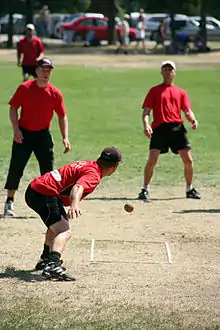Stånga Games
The Stånga Games (in Swedish Stångaspelen), also referred to as the "Gotland Olympic Games", is an annual sports competition in Stånga on the Swedish island of Gotland. The first Stånga Games were concluded on 27 July 1924. The games are held during five days around the second weekend in July and gathers about 2000 participants. Competitions are held in various Gutnish disciplines, some dating back to the Viking Age.[1]

History
The first competition was held in 1882. From the late 1880s, general Gotland athletics competitions were held several times per decade. In 1912, a special association was formed - "Föreningen Gotländsk Idrott" (FGI) with the mission of promoting the Gotland sports games. In 1924, FGI decided to arrange a Gothic sport competition in Stånga. Reinhold Dahlgren (1886-1968), a high school teacher from Östergarn organized the competition annually starting 1933 calling it officially Stångaspelen. The Stånga municipality gave the games a central location in Stånga with the new Stangmalmen racing stadium ready for competition in 1956.
When Reinhold Dahlgren retired at the age of 75, his sons Tore Dahlgren (1914-1973) and Anders Dahlgren (1924-1997) took over the responsibility of organizing the games.
Sports
- Varpa
- Pärk
- Caber toss
- Gutnish pentathlon
- Pillow fight on a pole (Herre på stång)
- Leg hook (Rövkrok)
- Hobble kick (Sparka Bleistre)
- Tug of war, eight-man teams (Dragkamp)
- Two-men tug of war, facing (Att dra hank)
- Two-men tug of war, back to back (Att täme stäut)
MVPs
|
Year, Team, Player
|
|
|
Bibliography
- Mattsson, Anders (1999). Stångaspelen 75 år Visby: Fören. Gutnisk idrott. (ISBN 91-85716-82-0)
References
- Molin, Maria (12 June 2015). "Stångaspelen för den oinvigde" [Stånga Games for the uninitiated]. www.gotland.net. Gotlands Media AB. Retrieved 24 June 2016.